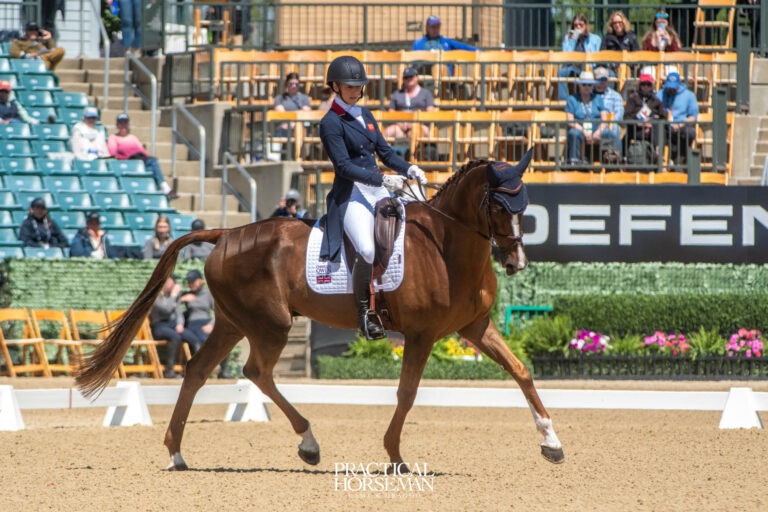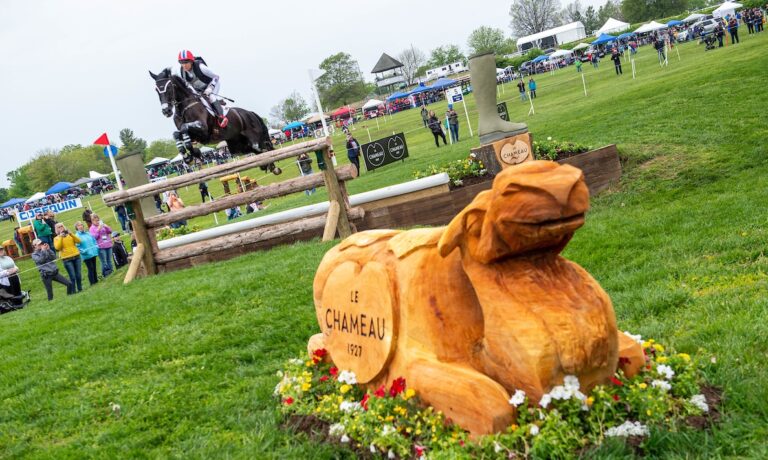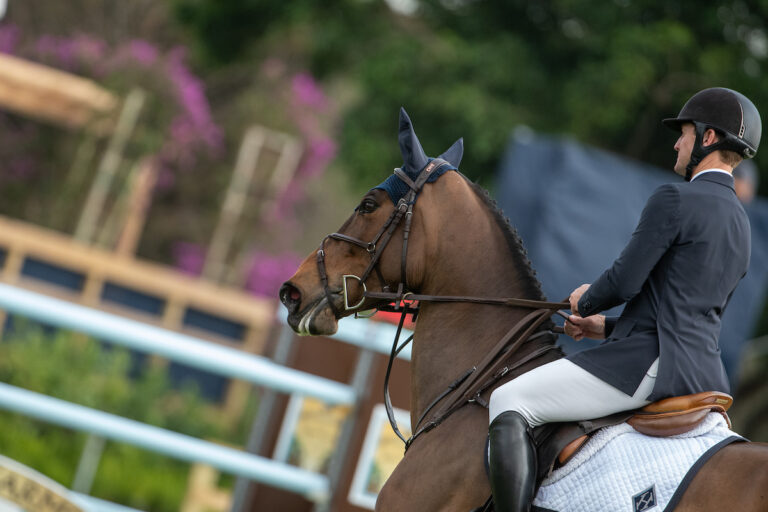The scoreboard doesn’t lie. As the last horse jumped the last show jump at the 2015 Rolex Kentucky Three-Day Event, presented by Land Rover, the scoreboard was flashing in huge neon letters, tastefully outlined with bling and sparkles, “Not competitive yet. Not yet. Not yet.” (Well, I made that part up, except about the bling and sparkles—there was plenty of that around.) What the scoreboard really showed was the usual domination of North American riders by European-based riders, who dropped in at the Kentucky Horse Park and walked away with more than $250,000 of the approximately $280,000 prize money offered. With this win, Germany’s Michael Jung establishes himself as the man to beat anywhere he competes. The KHP does not offer parimutuel betting yet, but if it had, you would not have gotten any odds against the rider people now simply call “The Terminator.”
Michael started his conquest of the eventing world by winning individual bronze at the 2009 European Championships. His gold-medal streak began when he won the individual gold medal at the KHP during the 2010 World Equestrian Games, then won the 2011 European Championships and the gold medal at the 2012 Olympic Games. (Oh, by the way, did I mention that he won the European Championships for the second time in 2013?) He then finally broke his gold-medal streak at the 2014 World Equestrian Games, where he finished with “only” a silver medal aboard his family’s lovely mare, fischerRocana FST. Possibly the reason he was the silver medalist there was that his gold-medal partner, La Biosthetique-Sam FBW, had suffered a minor injury before WEG.
However, Michael’s formerly second-string mare stepped into first place this year at Rolex and made it look easy. Be-ginning with the dressage, several other foreign riders made the work look easy as well, and it quickly became apparent that the event was going to boil down to the foreign riders—and then the North American contingent. Michael’s supporting cast was a list of international winners: perennial Rolex champion William Fox-Pitt had his 2014 Rolex winner, Catherine Witt’s Bay My Hero, and New Zealander Tim Price had brought Christina Knudson and the Wesko Syndicate’s Wesko, a winner at the Luhmühlen four-star last year. Michael and La Biosthetique-Sam FBW, owned by the Jung family (including his parents, Brigitte and Joachim Jung), Erich Single and the German Olympic Games Committee (DOKR), completed a fearsome foursome of horse-and-rider combinations that would be hard to beat anywhere in the world.
Our U.S. veterans—Phillip Dutton, Boyd Martin and Will Coleman—were kinda in touch with the leaders after the dressage tests, but when you head into cross-country day more than 10 points behind, you have a handicap that you probably will not be able to overcome. The brightest part of the dressage for U.S. eventing fans was that two lesser-known U.S. riders produced personal-best performances: Colleen Rutledge on her homebred Covert Rights and, in her first appearance at Rolex, Elisa Wallace aboard Jill and David Hopcroft’s Simply Priceless.
The talk in the barn after the dressage was that cross-country course designer Derek di Grazia had built his biggest and best course yet, and Rolex 2015 would not be a dressage competition. This was an interesting change in riders’ attitudes. In years past, competitors have tended to underestimate Derek’s courses. A winner here at Rolex himself in 1985, Derek understands the game and gets his results with subtlety rather than trickery. This was the first course I have seen in years that truly went across the country, using the natural rise and fall of the terrain rather than an endless succession of angles, corners and tricks.
To help myself analyze courses, I produce a statistical breakdown of every major cross-country course I walk, tracking when the horse needs some form of technical assistance from the rider, and convert the results to a percentage. For example, the courses of Mike Etherington-Smith, who designed at the KHP for years, typically scored in the 60 percent range on my scale—meaning that at two out of three of his obstacles, the horse needed some form of technical help. When Derek started designing here, he usually designed courses that were in the high 40 percent range. This year’s scored 37 percent—quite a change.
Derek has shown his fellow designers how to design a course that is very difficult without being tricky. This year’s course was already hard enough, but a cold, driving rain throughout the day made the effort not one for the fainthearted. I was impressed at how well the experienced riders handled difficult conditions and disappointed at how timid some of the less-experienced riders looked. They obviously were put off by the rough going and their riding suffered. Cross-country conditions at both the 2014 WEG and 2015 Rolex remind us that eventing requires riders who are not just technically proficient but tough-minded as well.
Fortunately, show jumping was held in perfect weather, and stadium-course designer Richard Jeffery put up a course that required a good deal of jumping. Statistics again: In past years, riders in the final phase have added an average of six penalty points to their score. This year the average penalties added were more than 10 points per rider. Pundits are still arguing about the show-jumping results: Although out of 40 horse-and-rider combinations eight jumped double clear (no knockdowns or time faults), some say the course was too difficult. For my part, I thought that, as usual, Richard had gotten it about right. The difficulty was in part a reflection of the high number of “Rolex rookies” participating. Some of them had a deer-in-the-headlights look as they galloped around the arena. Experience is what you get right after you needed it, and they will be better next time. The high show-jumping scores were also a reminder from the eventing gods that if riders take too much out of their horses on cross country, they will pay the price in the show-jumping arena. While that argument will continue, there is no argument that Michael Jung and fischerRocana FST are the best in the world right now.
Rolex Results
Place Rider/Horse Score
1. Michael Jung (GER)/fischerRocana FST….39.3
2. Tim Price (NZL)/Wesko….40.3
3. Michael Jung (GER)/La Biosthetique-Sam FBW….44.7
4. William Fox-Pitt (GBR)/Bay My Hero….46.9
5. Phillip Dutton (USA)/Fernhill Cubalawn….54.1
6. Will Coleman (USA)/OBOS O’Reilly….56.6
7. Boyd Martin (USA)/Master Frisky….56.6
8. Nicola Wilson (GBR)/Annie Clover….56.8
Michael Jung and fischerRocana FST
1. Michael Jung and fischerRocana FST (Roxie), the winners of Rolex 2015, were giving out free riding lessons all week. Michael’s success can be summed up with three words: technique, technique, technique. No matter the situation, he is always in the correct position and using the correct aids. Although he and his lovely mare left long to the first table at the Horse Park Barns (19A), Michael is letting Roxie jump it while already planning his 180-degree turn back to the second table at Fence 19B.
One of the many things I admire about Michael’s riding is that he never, but never, moves his hand forward before his horse asks for it. This explains why his horses are always in such an admirable balance at the takeoff point. Although he is out of the saddle, his elbows are still compressed, meaning Roxie has not yet used her neck. His solid lower leg makes this possible and allows him to look left and start the turning function of his reins.
 © Amy K. Dragoo/Aimmedia
© Amy K. Dragoo/Aimmedia2. There is no doubt in Roxie’s mind what Michael wants to happen next: land on the left lead and turn toward the identical table at 19B. He is cheating with his right hand, placing his thumb over the mane for stability. His eyes are already looking at the part of the next table he intends to jump. Michael is just out of his saddle, but if he were seated, he would have less than a 90-degree angle behind his knee. This is shorter than most U.S. competitors ride cross country and explains why he is so much more stable in his position.
 © Amy K. Dragoo/Aimmedia
© Amy K. Dragoo/Aimmedia3. If Michael had a laser beam coming out of his eyes, it would burn a hole in the top of the next obstacle. He has his line (really a curve) to the next fence; now he just has to stay on it. Roxie’s eyes tell us she understands Michael’s aids, and she is starting to look over her shoulder for something more to do. Note that Michael’s elbows are following Roxie’s mouth, but he is not bending over. This is another hallmark of Michael’s technique: He follows his horse’s mouth with his arms, not his body.
 © Amy K. Dragoo/Aimmedia
© Amy K. Dragoo/Aimmedia4. At the apex of the turn, Michael still has his right hand locked on the mane. Riders do this to block the action of the outside shoulder and support a turn to the inside. At this point, you should suspect that Michael knows something about the course that we don’t know. If you want to know why event riders spend so much time practicing dressage, look at the engagement of Roxie’s hindquarters. You will not see many high-speed turns done in a better balance than this one.
 © Amy K. Dragoo/Aimmedia
© Amy K. Dragoo/Aimmedia5. Now we understand why Michael has been controlling his mare’s right shoulder. The small cedar trees have been carefully placed to push horses and riders to the outside of their line, creating a possible glance-off the fence to the right. Michael spotted this when he walked the course, and he has been taking care of business ever since. His eyes have never wavered from the exact part of the table he wants to jump.
 © Amy K. Dragoo/Aimmedia
© Amy K. Dragoo/Aimmedia6. If I had showed only this photograph, instead of the entire sequence, you would have glanced at it and moved on. Nothing special to see an Olympic and World Equestrian Games gold-medal winner sitting well over a table, right? But when you see the entire series of photos, you get an insight into why Michael Jung is so successful—technique, technique, technique. Of course, it helps that Roxie is talented—and cute!
 © Amy K. Dragoo/Aimmedia
© Amy K. Dragoo/AimmediaTim Price and Wesko
I was not surprised that Tim Price and Wesko (Dash) went so well at Rolex. This pair had won at the four-star level last summer at Luhmühlen, Germany; they are established stars at this level. Dash is one of those rare horses who can do all three parts of an event equally well, and Tim has the skill set to match. Tied for first after the dressage, they had one of the fastest cross-country times of the day yet never looked as if they were in a hurry. One heart-breaking knockdown in the show jumping moved them to second place, but Dash is relatively young at 12 years old, and they are a force to be reckoned with in the future.
 © Jenni Autry
© Jenni AutryModern eventing requires both physical and mental toughness. In the photo below, you can tell from the crowd and from Tim’s clothing that everyone on the cross-country course at Rolex 2015 got drenched to the bone. Tim is ignoring the conditions. He has a job to do late in a Derek di Grazia course. Derek’s courses require total concentration from the first to last fence, and riders must be mentally tough to succeed. The carved goose obstacle shown here at the Water Park (26B) is bigger than it looks and placed in the middle of a pond (see photo above). Water can drag a horse’s balance down if the rider does not compensate. At this instant, Dash is looking straight ahead, but Tim’s aids are saying, “No buddy, there is one more over there.” That one more is an uphill approach on a curve to a huge and very narrow brush. Tim applies his left leg behind the girth, left neck rein, right open rein and looks where he wants Dash to go. Although Dash momentarily misunderstood the rest of the combination, he heard Tim’s aids and reacted instantly and correctly. By the time they jump it, you would think Dash had walked the course along with Tim.
 © Amy K. Dragoo/Aimmedia
© Amy K. Dragoo/AimmediaPhillip Dutton and Fernhill Fugitive
I love photos shot at slightly unusual moments. They often tell me more than the typical photo taken over the top of the obstacle. I especially love looking at them when they include horses and riders as good as Phillip Dutton and Fernhill Fugitive (Jack), shown here at the Land Rover Hollow (18A). Phillip is riding better than he has in years, which must be reassuring to the U.S. team selectors. I have been teasing U.S. Eventing Team Chef d’Equipe David O’Connor that of all the riders he is dealing with, his most experienced rider is getting the greatest benefit.
 © Amy K. Dragoo/Aimmedia
© Amy K. Dragoo/AimmediaPhillip certainly put his considerable experience to work at Rolex 2015, placing ninth with Jack and fifth with another horse, Fernhill Cubalawn (Cuba), at Cuba’s first four-star. This is especially notable when you consider that all the horses in front of Cuba in the final placings have either won four-stars or World Championship individual medals! This photo gives you an insight into Phillip’s expertise. Due to a superb lower-leg position, he is landing in perfect balance with Jack equally balanced on both reins. His aids are already applied for a right-hand curve down to a narrow obstacle, shown in the inset photo at right. Atmospheric conditions affected our photographs and prevent me from showing you how Phillip and Jack handled the rest of the combination, but looking at the first obstacle, you already know how the rest will turn out.
 © Amy K. Dragoo/Aimmedia
© Amy K. Dragoo/AimmediaColleen Rutledge and Shiraz
Colleen Rutledge and Shiraz (Luke) have just jumped the same 3-foot-11 log with a 6-foot-6 drop at the Land Rover Hollow (18A) that Phillip is shown jumping above. Here Colleen and Luke are a few strides later at 18B. I am impressed by Colleen’s position here. It should be entered in Practical Horseman’s popular monthly Jumping Clinic with George Morris. Her lower leg is correct, back flat, eyes ahead with a straight line from her elbow to Luke’s mouth.
 © Amy K. Dragoo/Aimmedia
© Amy K. Dragoo/AimmediaBut what about Luke? Well, Luke cracks me up. His ears are at half-mast, he has a bored expression on his face (“Is that all you got?”) and he has pushed the brush out of the way rather than make any kind of jumping effort. I guess you are entitled to that sort of attitude if you are the only horse in history to ever jump seven (yes, seven) four-star cross-country courses clean. Although age 17, Luke turned in the fastest round of the day, finishing nearly 20 seconds under the optimum time and still pulling at the end. As he galloped through the timers, I could hear him thinking, “Take that, all you young whippersnappers.”
Luke is a Classic-format horse in a short-format world, and he has never gotten the recognition that he would have received in a different century. If he had been born 50 years ago, he would have a tack trunk full of Olympic and World Championship medals. Still, he has set a record that will not be broken in our lifetimes. We were fortunate to see the “Look of Eagles” in action at Rolex 2015.
Boyd Martin and Master Frisky
When Boyd Martin moved to the United States from Australia, he brought his cross-country skills with him. Shown here with Master Frisky at the Sod Top Cabins (28A), Boyd is obviously taking the direct line between the two cabins (see inset). I mentioned earlier that Derek di Grazia used the terrain to make his courses more difficult, and you can see a bit of that here. Notice how the ground falls away slightly to Boyd’s left, which increases the difficulty of making a right-hand curve to a similar cabin at 28B. Boyd is well aware of this and has his eyes firmly fixed on his line. Like William Fox-Pitt and Will Coleman, Boyd is quite tall, but he has learned how to sit still on his horse.
 © Amy K. Dragoo/Aimmedia
© Amy K. Dragoo/AimmediaThere is a rumor that RuPaul is Boyd’s new fashion consultant, but I was unable to confirm that before I had to go to publication. I just love the nice coordination between Boyd’s saddle trim, his stirrups and even the tape on Master Frisky’s galloping boots with the added touch of the jump-number signs all in glowing shades of azure and cobalt, although Boyd’s stirrups have a bit too much turquoise to suit me. This might spoil an otherwise perfect metrosexual look. But I’m being picky because the entire ensemble just works for Boyd, don’t you think?
 © Jenni Autry
© Jenni AutryThis article originally appeared in the July 2015 issue of Practical Horseman.










